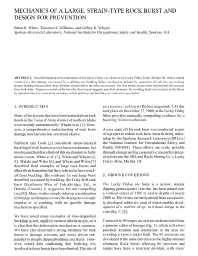Mining Publication: Mechanics of a Large, Strain-Type Rock Burst and Design for Prevention
Original creation date: July 2002
Detailed mapping and examination of the site of a large rock burst at the Lucky Friday Mine, Mullan, ID, demonstrated conclusively that damage was caused by a splitting and buckling failure mechanism initiated by separation of rock into layers along steeply dipping metamorphic shear foliation subparallel to the affected crosscut. The thin tabular layers then buckled into the crosscut from both sides. Rigorous control of the burst by these layers suggests practical measures for avoiding bursts in crosscuts in the future by repositioning and reorienting openings so that splitting and buckling are reduced or precluded.
Authors: BG White, TJ Williams, JK Whyatt
Conference Paper - July 2002
NIOSHTIC2 Number: 20030440
NARMS-TAC 2002: Mining and Tunnelling Innovation and Opportunity, Hammah R, Bawden W, Curran J, Telesnicki M, eds. Vol 2. Toronto, Ontario, Canada: Univ. of Toronto, Toronto, July 7-10, 2002; :1095-1100
See Also
- 60 Years of Rockbursting in the Coeur D'Alene District of Northern Idaho, USA: Lessons Learned and Remaining Issues
- Coal Mine Burst Prevention Controls
- Comparison of Ground Conditions and Ground Control Practices in the United States and Australia
- Determination of In Situ Deformation Modulus for Cemented Rockfill
- Development of a Statistical-Analytical Approach for Assessing Coal Bump Potential
- Diagnosing and Controlling Moisture-Sensitive Roof in Coal Mines
- Dynamic Failure in Deep Coal: Recent Trends and a Path Forward
- Numerical Model Calibration for Simulating Coal Pillars, Gob and Overburden Response
- Rock Bursting and Seismicity During Ramp Development, Lucky Friday Mine, Mullan, Idaho
- The Role of Gas Desorption in the Energetic Failure of Coal
- Page last reviewed: 9/21/2012
- Page last updated: 9/21/2012
- Content source: National Institute for Occupational Safety and Health, Mining Program


 ShareCompartir
ShareCompartir
